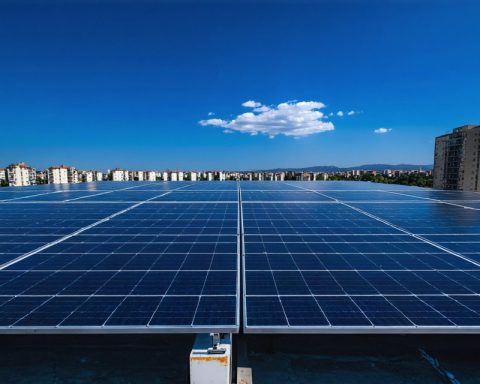- Solar power is becoming a key player in sustainable energy, driven by a need to combat climate change and decreasing technology costs.
- The cost of solar photovoltaic cells has dropped nearly 90% since 2009, making solar energy one of the most affordable power sources globally.
- Innovative solutions, such as floating solar farms, optimize land use, reduce water evaporation, and enhance efficiency.
- Community solar projects in the U.S. allow residents to share solar benefits and lower energy bills without individual installations.
- In developing regions like Sub-Saharan Africa, solar power provides crucial access to electricity, improving education, healthcare, and economic opportunities.
- Collaboration across sectors is essential to maximize solar power’s potential and support global sustainability efforts.
Imagine a world where the relentless energy of the sun transforms societies, powering homes, cities, and even entire industries. This vision is becoming a reality as nations increasingly embrace solar power in their quest for sustainable energy.
Stepping into the sun-drenched fields of Andalusia, Spain, one cannot help but marvel at the vast sea of photovoltaic panels glinting under the azure sky. These modern marvels capture the sun’s rays, converting them into clean, renewable electricity. Once barren landscapes now hum with the promise of a greener tomorrow.
Solar Power’s Meteoric Rise
Solar energy’s dominance is no accident. It stems from an urgent need to combat climate change and the plummeting costs of solar technology. Since 2009, the cost of solar photovoltaic cells has decreased by nearly 90%, making solar one of the most affordable sources of power worldwide. International agreements like the Paris Accord have galvanized countries to reduce greenhouse emissions, propelling the solar industry to new heights.
Floating Solar Farms: A Revolutionary Concept
Water bodies often reflect the serene blue of the sky, but they are increasingly becoming fertile grounds for floating solar farms. China, a leader in renewable energy, has inaugurated the world’s largest floating solar plant on a lake formed over a collapsed coal mine in Huainan, Anhui. This innovative approach not only harnesses renewable energy but also makes efficient use of space, reduces water evaporation, and keeps the equipment cooler, enhancing efficiency.
Community-Powered Solar Networks
Beyond the impressive statistics and technology lies a critical element—people. Communities are at the heart of the solar revolution. Take, for instance, the thriving model of community solar projects cropping up in the United States. These initiatives allow local residents to share the benefits of solar power without having to install panels individually. Participants tap into a shared array, reaping financial savings on energy bills and promoting local job creation.
Empowering the Developing World
For many, especially in developing regions, solar represents more than clean energy; it is empowerment. In Sub-Saharan Africa, where over 600 million people lack access to electricity, solar power is transforming lives. Solar home systems and microgrids provide reliable energy to remote villages, enhancing education, healthcare, and economic opportunities.
The Future is Bright
As the world accelerates towards a sustainable future, solar power remains a beacon of hope. It compels us to rethink our relationship with nature and energy consumption. Policymakers, businesses, and individuals must collaborate to continue reducing carbon footprints and invest in solar innovations.
The sun rises anew each day, an enduring symbol of energy and life. By harnessing its power wisely, humanity takes a significant stride towards preserving our planet for future generations. Embrace the solar revolution and illuminate a cleaner, brighter, and sustainable tomorrow.
Unveiling the Solar Revolution: Transforming Landscapes and Lives
Key Insights into the Solar Energy Boom
The global adoption of solar energy is more than just an environmental boon; it’s an economic and societal shift redefining how we live. Below are additional facts and insights that delve deeper into the solar phenomenon.
How Solar Energy is Reshaping Industries
1. Cost-Effectiveness: The drastic 90% reduction in solar photovoltaic costs since 2009 is fostering widespread adoption. This economic incentive is not just impactful at the consumer level but also makes solar power a viable option for large-scale industrial applications.
2. Job Market Evolution: The solar industry is one of the fastest-growing sectors in renewable energy. According to the International Renewable Energy Agency (IRENA), the sector has created over 4 million jobs globally, encompassing roles from manufacturing to installation and maintenance.
3. Technological Advancements: Emerging technologies like solar panels with improved efficiency and durability, bifacial panels that capture sunlight on both sides, and innovations in storage solutions are driving industry growth.
Real-World Applications and Insights
– Floating Solar Innovations: Floating solar farms, such as China’s pioneering projects, maximize space usage and reduce the need for large land areas, which is particularly beneficial in densely populated regions.
– Community Solar Power: This model is gaining traction as it democratizes access to solar energy. It reduces the barrier to entry for renters and those unable to install panels on their properties.
Market Forecasts and Industry Trends
– Projected Growth: The global solar energy market is expected to reach $223.3 billion by 2026, growing at a CAGR of 20.5% from 2019 to 2026 ([Allied Market Research](https://www.alliedmarketresearch.com)).
– Energy Storage Solutions: As solar adoption increases, so does the demand for efficient energy storage systems like lithium-ion and flow batteries, which will play a critical role in balancing supply and demand.
Pros and Cons Overview
Pros:
– Environmentally friendly: Reduces reliance on fossil fuels.
– Economic benefits: Lowers electricity bills, especially where incentives are available.
– Energy independence: Reduces dependency on grid supply.
Cons:
– Intermittency: Solar energy is weather-dependent.
– Initial investment: High upfront costs for installation, although offset by long-term savings.
– Land use: Large installations may impact land availability for other purposes.
Addressing Key Reader Questions
– Is solar energy viable in cloudy climates?
Yes, solar panels can still generate electricity in cloudy conditions, albeit at reduced efficiency. Technology advancements are continually improving the ability of solar cells to capture diffuse light.
– How does solar energy impact property values?
Studies indicate that homes with solar energy systems typically sell faster and at premium prices compared to non-solar homes, particularly in sunny regions.
Actionable Recommendations
1. Evaluate Solar Potential: Use online tools like Google’s Project Sunroof to assess your property’s solar potential and potential savings.
2. Stay Informed: Monitor local and federal incentives or rebates which can substantially reduce installation costs.
3. Consider Community Solar: If rooftop installation isn’t an option, explore local community solar projects to participate in the solar movement.
4. Invest in Energy Storage: To address solar intermittency, consider pairing solar installations with storage solutions.
For more on solar energy advancements and how to become part of this transformative movement, visit the International Energy Agency.
The solar revolution is more accessible than ever. By embracing solar power, individuals and communities can contribute to a sustainable future, making an impactful difference for generations to come.


















